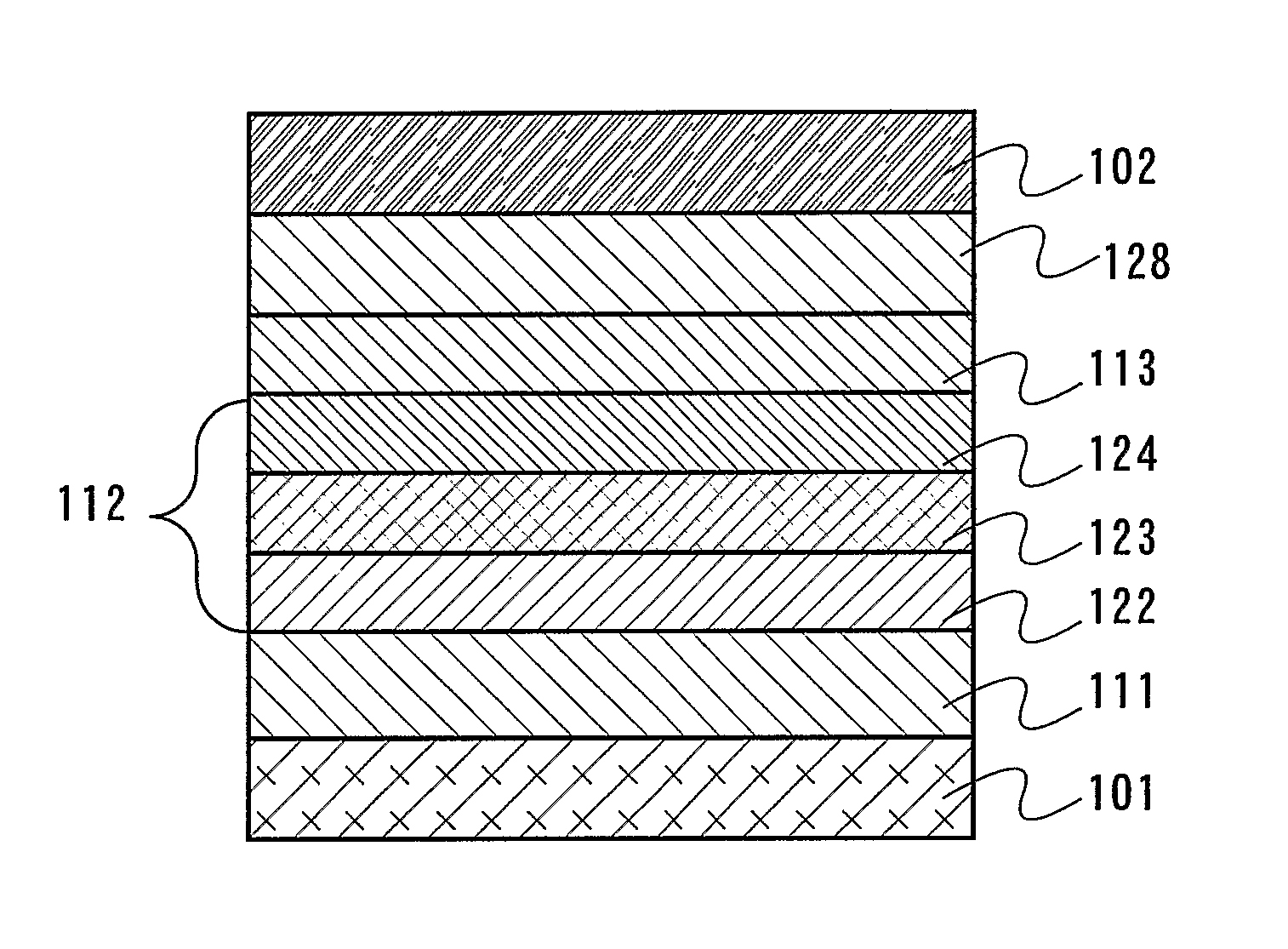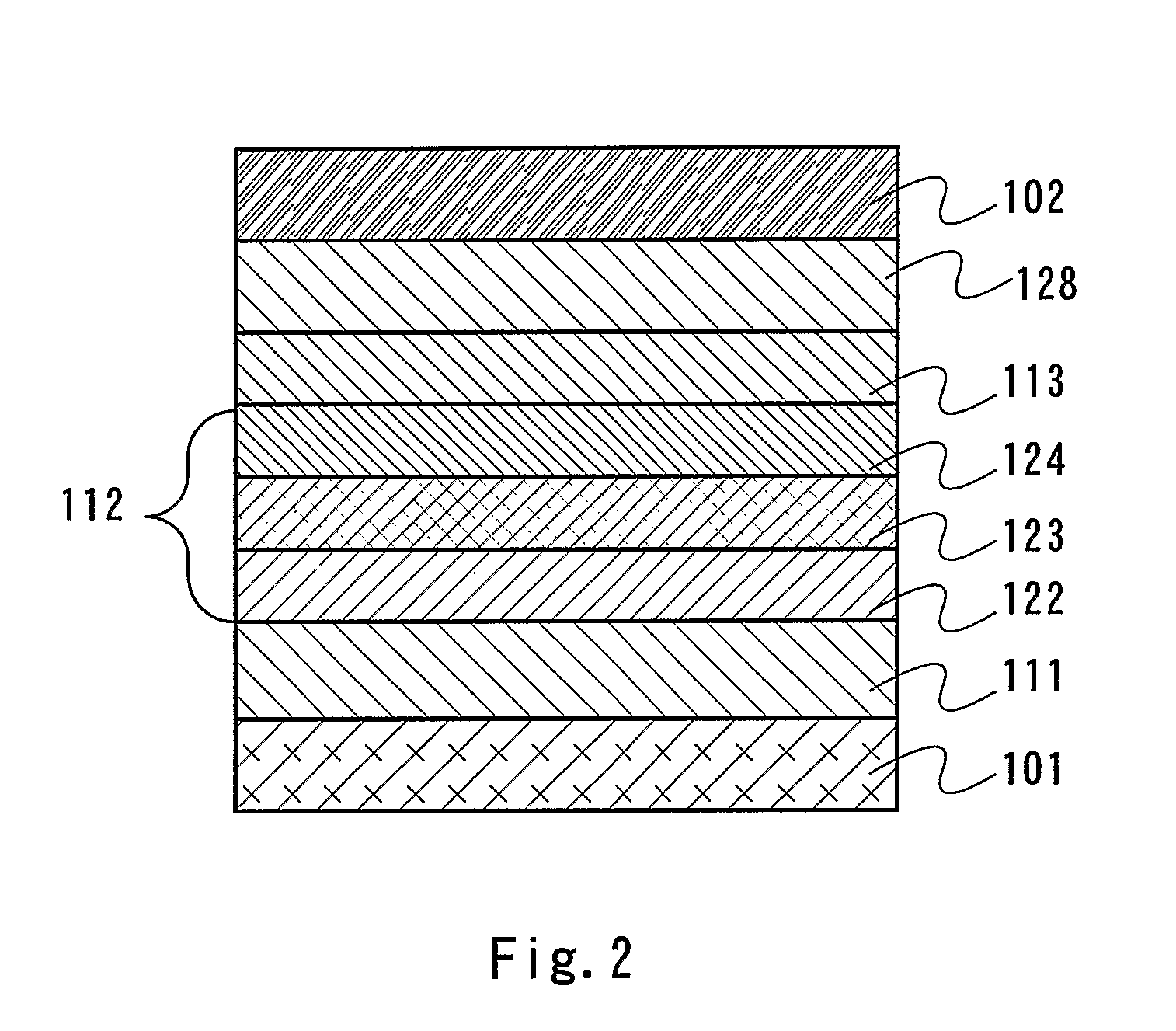Light-emitting element and light-emitting device using the same
a technology of light-emitting devices and light-emitting elements, which is applied in the direction of discharge tube luminescnet screens, other domestic articles, natural mineral layered products, etc., can solve the problems of insufficient document 1 alone and the need for much lower driving voltage, and achieve low driving voltage and not increased driving voltage. , the effect of producing favorable yield
- Summary
- Abstract
- Description
- Claims
- Application Information
AI Technical Summary
Benefits of technology
Problems solved by technology
Method used
Image
Examples
embodiment 1
In the present embodiment, an example of a light-emitting element using a layer including an inorganic compound and an organic compound that has a glass-transition temperature of 150° C. or more, preferably 160° C. or more and 300° C. or less, will be described with reference to FIG. 1, where a benzidine derivative is used as the organic compound. It is to be noted that benzidine derivative according to the present invention is a compound having a spiro ring and a triphenylamine skeleton.
As shown in FIG. 1, the light-emitting element according to the present invention has a first electrode 101 and a second electrode 102 that are opposed to each other, and has a first layer 111, a second layer 112, and a third layer 113 that are stacked in this order from the first electrode 101 side. When a voltage is applied to this light-emitting element so that the potential of the first electrode 101 is higher than the potential of the second electrode 102, a hole is injected from the first laye...
embodiment 2
An example of a light-emitting element using a layer including a benzidine derivative according to the present invention, which is a compound having a spiro ring and a triphenylamine skeleton, and an inorganic compound will be described with reference to FIG. 18.
As shown in FIG. 18, the light-emitting element according to the present invention has a first electrode 101 and a second electrode 102 that are opposed to each other, and has a first layer 111, a second layer 112, and a third layer 113 that are stacked in this order from the first electrode 101 side. When a voltage is applied to this light-emitting element so that the potential of the first electrode 101 is higher than the potential of the second electrode 102, a hole is injected from the first layer 111 into the second layer 112, and an electron is injected from the third layer 113 into the second layer 112. The hole and the electron are recombined to excite a luminescent material. Then, luminescence is produced when the e...
embodiment 3
In the present embodiment, the structure of a light-emitting element that is different from the embodiments-described above will be described.
As shown in FIG. 2, the light-emitting element shown in the present embodiment has a first electrode 101 and a second electrode 102 that are opposed to each other, and has a first layer 111, a second layer 112, a third layer 113, and a fourth layer 128 that are stacked in this order from the first electrode 101 side, where it is a feature that the fourth layer 128 is provided. The fourth layer 128 can be formed by using the same material as the first layer 111, and the other structure is the same as the embodiment described above. Therefore, description of the structure other than the fourth layer 128 is omitted.
When the fourth layer 128 is provided in this way, damage during forming the second electrode 102 can be further reduced.
Further, a layer in which an organic compound and an inorganic compound are mixed is preferably used for the fourt...
PUM
| Property | Measurement | Unit |
|---|---|---|
| glass-transition temperature | aaaaa | aaaaa |
| glass-transition temperature | aaaaa | aaaaa |
| glass-transition temperature | aaaaa | aaaaa |
Abstract
Description
Claims
Application Information
 Login to View More
Login to View More - R&D
- Intellectual Property
- Life Sciences
- Materials
- Tech Scout
- Unparalleled Data Quality
- Higher Quality Content
- 60% Fewer Hallucinations
Browse by: Latest US Patents, China's latest patents, Technical Efficacy Thesaurus, Application Domain, Technology Topic, Popular Technical Reports.
© 2025 PatSnap. All rights reserved.Legal|Privacy policy|Modern Slavery Act Transparency Statement|Sitemap|About US| Contact US: help@patsnap.com



